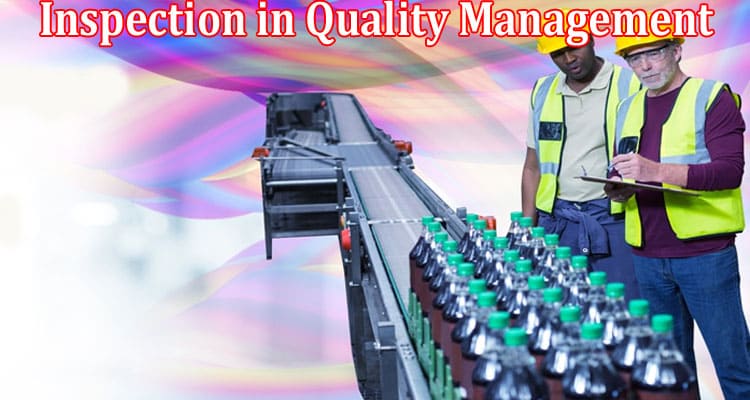5 Key Functions of Inspection in Quality Management
Introduction
Inspection is an essential instrument for achieving the quality concept. It’s important to give the manufacturer confidence and pursue customer satisfaction. Inspection is a critical component in today’s production processes. It aids in quality control, minimizes production costs, eliminates scrap losses, and removes assignable factors for mediocre performance.
The test unit and inspection evaluate both the service or quality of the manufactured product and the quality of the incoming components and raw materials. It analyses the components at several stages in light of specific predetermined factors, identifying and classifying defective items. It also includes instructions on measuring the product quality and the kinds of inspection tools to employ.
The most popular way to achieve uniformity, standardization, and high-quality workmanship is through inspection. In the case of variables, inspection merely assesses the level of conformity to a standard. Inspection only distinguishes between conforming and nonconforming attributes in the case of attributes. An inspection does not reveal the cause of the production of nonconforming units.
Key Functions of Inspection in Quality Management
After comparing the production quality to specified specifications and standards, it is the cost-art of controlling quality. It carries out quality control. The item in question will only be accepted if it falls within the acceptable range. Corrective measures will be taken to ensure that similar items in the future adhere to the required requirements.
Below are five key functions of inspection in quality management:
Maintenance of Outlined Standards for Product Quality
Documentation is a crucial component of the processes of quality management. It outlines the product quality standards that must be followed throughout inspections, audits, and quality checks. It also guides your quality teams, auditors, and suppliers. The documentation of all quality management operations also demonstrates your company’s commitment to best practices and quality culture.
Finding Errors at the Source to Lessen Waste and Substandard Work
Sadly, some companies view inspections as the last step in the quality control process. It’s past time for companies to reconsider their inspection procedures. Streamlining inspections from the beginning can aid in lowering the amount of waste and substandard goods produced. Additionally, it will aid them in preserving their brand reputation and minimizing overhead costs brought on by workplace accidents, compliance lawsuits, or other catastrophic occurrences.
Keeping Inspection Equipment in Perfect Shape
You need to set the inspection equipment much like the production equipment. It will aid in maintaining the equipment’s effectiveness and accuracy. Over time, it will support maintaining product quality consistency. Ensure the inspection equipment is on the list the next time you arrange the calibration activity.
Offering Guidance to Workers When Production Issues Occur
Regulations are becoming more demanding over time. Employers must continually teach their staff members about these needs if they want them to do their jobs more successfully and efficiently. You can use a cloud-based training management system to give your staff a flexible training environment while working remotely.
Informing Management on the Causes of Manufacturing Issues
You must inform management of the incidents and the action plan you’ve put in place; this will allow them to make wise business decisions. They can also change and streamline the current inspection procedures with its assistance.
EC Global Inspection Services
It is known that experiencing these inspection functions within the tenet of your business inspection procedures can be daunting, especially when dealing with mass production. At this point, you need the services of an independent inspection company. To spare yourself the troubles of employing inspection techniques, you can consider taking advantage of the following EC Global Inspection services:
Pre-Production Inspection (PPI)
Pre-production inspections are the initial inspections that occur after a purchase order. The EC global quality control inspectors will visit your supplier’s facility during a PPI inspection to assess the quality of the components, raw materials, and other setups they are making for the production process.
The EC Global pre-inspection checklist includes, but is not limited to:
- Verifying the condition of the raw materials
- Inspecting the storage that is intended for your products
- Inspecting the quality plan and production readiness of a supplier
- Inspecting the measurement of raw materials, size, function, size, and other components
- Conducting the necessary safety and reliability tests
Retailers use pre-production inspections, among other things, to confirm that the supplier they are buying from is using the components and raw materials specified in the contract. Unfortunately, many undependable suppliers may attempt to use less expensive components and raw materials to save money. However, if these raw materials don’t work with your product, you will be responsible for handling returns, grievances, and other safety risks from customers.
Pre-Shipment Inspection (PSI)
A pre-shipment inspection (PSI), often referred to as a final random inspection, verifies that the supplier manufactured your products in accordance with your requirements and packed them in accordance with your purchase contract. This will only be carried out once the manufacturing process is completed and at least 80 percent of the order has been shipped. It will be based on a random sampling of products picked from the shipment.
The EC Global pre-shipment inspection checklist includes the following:
- Verifying the functionality and safety of manufactured products
- Evaluating the products’ quality and organizing any adjustments in price
- Confirming the order was manufactured in accordance with the specifications stated in the purchase contract
- Checking the product’s delivery marks, labels, and packaging
The primary benefit of conducting a pre-shipment inspection is that you can accurately represent the order without checking every product because products are selected randomly from the order. Additionally, the PSI inspection’s safety and performance tests will aid you in finding defective products so you can avoid paying for such.
Conclusion
That brings us to the end of this eye-opener journey on the “5 Key Functions of Inspection in Quality Management”. For your information, the functions of inspection in quality management exceed the ones mentioned in this post. To learn more about this exciting topic to take full advantage of the benefits it holds for you, EC Global Inspection is your best choice.




